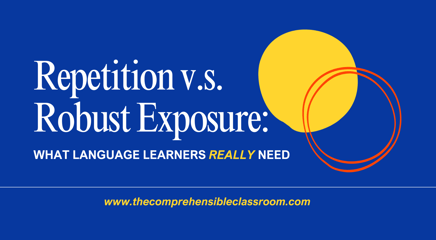I'm always on the hunt for new and different tasks for students to complete when listening to songs or other authentic resources, and this activity shared by Sharon Birch is a great one! Its flexible design allows it to used as a reading activity as well.

What is Q&A Match-Up?
In a Q&A Match-up, students have to match Questions with Answers. All of the questions are written about a text (either a written text or an audio text), and the answers are taken directly from the text as well. These questions and answers will likely all be QAR type "Right There" questions. As students read or listen to the text, they match the questions with answers.
How to prepare a Q&A Match-Up activity
Begin by finding a text that you want students to read or listen to. It does not have to be an authentic text; this activity works with any text type.
First, listen to (or read) the text several times. Consider your students' interpretive ability, and consider what words, phrases, and sentences they will best be able to understand. Take into account the rate of speech and the way that the speaker might blend words together, or places in which the speaker is easier or harder to hear. Consider which words and expressions your students know with confidence, and which ones they would be able to make sense of with a little extra support.
Next, write questions about those parts of the text that the students can probably understand. If I am doing this as an activity in class, I write the questions in the target language (in my case, Spanish).
Write answers to the questions, and create an answer bank. Add some "dud" answers to the bank as well. This will prevent students from being able to simply match questions and answers based on logic: for example, most any student could guess that a "How many?" question will have an answer that includes a number. If I am using this as an activity in class, I write the answers in the target language as well.
Check out this example assessment (with questions and answers in English) from Brandon Brown dice la verdad by Carol Gaab, available from www.waysidepublishing.com.

Project the questions and answer bank while students read or listen to the text, or make printable copies for students to write on. If it is a listening text, I allow students to listen to it 3-5 times (depending on length and difficulty) in order to match the questions and answers.
Why I love Q&A Match-Up
Using this Q&A Match-up activity gives students a purpose for listening. It directs their focus, and it helps them to pull out the information that they can best understand–because YOU, the teacher, have curated the content for them! You've prepared questions that you know that they can answer and that you know will help them to be able to understand and discuss the text.
Can I use this activity as an assessment?
Absolutely! This task makes for a great Interpretive assessment--but only if you write the questions and answers in English about the text, which is in the target language.
Why assess L2 comprehension in L1?
This is a really important question! The danger with asking questions about an L2 text in L2 is that students might be able to respond correctly without actually understanding what the words mean. A good test taker can match questions and answers by looking at word chunks, not knowing what those chunks mean.
I typically have my students complete text-based activities in the target language, but assessments are nearly always done in English (my students' L1). Read more here!
If I'm using it as an activity, how do I grade it?
The vast majority of my students' grade is based on performance on summative assessments (Reading, Listening, Writing, sometimes Speaking).
If I use this as an activity in class, it is marked for complete/incomplete/not complete, and goes into the Work Habits category in my gradebook– which accounts for just 5% of the overall grade. Learn more about my gradebook categories here.





